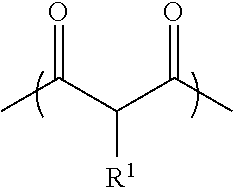Process for preparing an acetoacetyl functional polymer
a technology of functional polymers and acetoacetyl, which is applied in the direction of coatings, etc., can solve the problems of limited impact on existing processing facilities and the application of acetoacetyl functional polymers, and achieve the effect of reducing aldehydes and improving formaldehyde absorption efficiency
- Summary
- Abstract
- Description
- Claims
- Application Information
AI Technical Summary
Benefits of technology
Problems solved by technology
Method used
Image
Examples
examples
[0038]Some embodiments of the present disclosure will now be described in the following Examples, wherein all parts and percentages are by weight unless otherwise specified.
[0039]Acetoacetoxyethyl methacrylate (AAEM) is available from Eastman Chemical.
[0040]Styrene (“ST”) and methyl methacrylate (“MMA”) are both available from The Dow Chemical Company.
[0041]n-Dodecyl mercaptan (“nDDM”), available from Sinopharm Chemical Reagent Co. Ltd. (SCRC), is used as a chain transfer agent.
[0042]Polyvinyl alcohol (PVA) (3 wt % aqueous solution), available from SCRC, is used as a stabilizer.
[0043]Poly(diallyldimethylammonium chloride) (PDMAC) (15 wt % aqueous solution), hydroxypropyl methylcellulose (HPMC) (2 wt % aqueous solution), and gelatin, all available from The Dow Chemical Company, are used as stabilizers.
[0044]Benzyl peroxide (BPO), lauroyl peroxide (LPO), and azobisisobutyronitrile (AIBN), all available from The Dow Chemical Company, are used as initiators.
[0045]The following standard ...
example
(Ex) 1
[0072]A one liter, three neck reactor equipped with a condenser, a mechanical stirrer and inlet for nitrogen (N2) was fed with deionized (DI) water (400 g), PDMAC (10.4 g) and gelatin (0.3 g). The obtained water phase was heated to 75° C. under a gentle N2 flow. In a separate container, oil phase was prepared by mixing monomers, an initiator, and a chain transfer agent (CTA) if used, based on formulations given in Table 1. Agitation was applied to completely dissolve the initiator. Then the oil phase was added into the water phase under mild agitation (agitation speed is given in Table 1). The resultant reaction mixture was then heated up to 85° C. After 30 min, another shot of gelatin (0.3 g) was added into the reactor. The reaction proceeded for 3 hours and further continued at 107° C. for half an hour, which is defined as the oil bath temperature. This is to further boost the conversion of monomers. After that, the reactor was cooled down to room temperature. The micro-bead...
PUM
| Property | Measurement | Unit |
|---|---|---|
| particle size | aaaaa | aaaaa |
| temperature | aaaaa | aaaaa |
| diameter | aaaaa | aaaaa |
Abstract
Description
Claims
Application Information
 Login to View More
Login to View More - R&D
- Intellectual Property
- Life Sciences
- Materials
- Tech Scout
- Unparalleled Data Quality
- Higher Quality Content
- 60% Fewer Hallucinations
Browse by: Latest US Patents, China's latest patents, Technical Efficacy Thesaurus, Application Domain, Technology Topic, Popular Technical Reports.
© 2025 PatSnap. All rights reserved.Legal|Privacy policy|Modern Slavery Act Transparency Statement|Sitemap|About US| Contact US: help@patsnap.com


